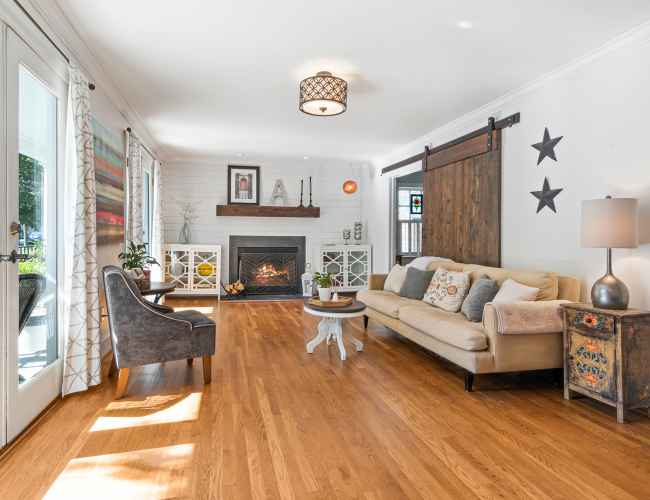In today’s world, the importance of accessibility in the home environment cannot be overstated. For individuals with disabilities, the elderly, or those requiring complex care, a home that is designed to be accessible is key to promoting independence, safety, and overall well-being. Accessibility isn’t just about removing barriers; it’s about creating spaces that support everyday living while maintaining dignity and comfort.
Home construction services are crucial in making this a reality. These services offer more than just cosmetic changes—they transform spaces into environments that accommodate specific needs, enhance mobility, and provide the comfort necessary for individuals to thrive. By integrating practical modifications, these services allow people to live more independently, engage with their surroundings more easily, and reduce the risks associated with poor design.
A well-modified, accessible home can have a profound impact on one’s quality of life. It can enable individuals to carry out daily tasks with greater ease and confidence, significantly reducing the physical and mental strain often associated with mobility challenges. At Grace Care, we understand the importance of this, and our home construction services play a vital role in helping individuals regain autonomy and live with greater freedom.
What is accessibility?
Accessibility refers to the design and adaptation of a home to ensure that all spaces, fixtures, and features are usable by people with varying abilities. In the context of a home, this means creating an environment where individuals—especially those with disabilities, the elderly, or people with complex care needs—can move around freely, perform daily activities independently, and remain safe in their own spaces.
Accessibility in the home goes beyond ramps and wider doorways. It involves thoughtful adjustments to both large and small elements in the home, like installing grab bars, adjusting counter heights, or ensuring that the home’s layout accommodates mobility devices. The goal is to eliminate obstacles, both physical and cognitive, so that individuals can live in comfort and security.
For people with disabilities, the elderly, or those with complex care needs, accessible home environments are not just an option—they are a necessity. These modifications enable them to live more independently, enhance safety, and improve their quality of life. Accessibility features also reduce the need for constant assistance, fostering a greater sense of autonomy and dignity.
Why Accessibility Matters for People with Special Needs
Many individuals face daily challenges that can make simple tasks feel daunting or even dangerous. For those with mobility challenges, like wheelchair users or individuals with limited leg strength, navigating spaces without proper modifications can be frustrating and physically harmful. Similarly, cognitive impairments such as dementia or autism require special home adaptations to create an environment that is safe, calming, and intuitive.
Examples of conditions that impact daily life include:
- Mobility Challenges: Conditions like arthritis, spinal cord injuries, or muscular dystrophy can affect movement and require modifications such as ramps, wider doorways, and bathroom aids like grab bars.
- Cognitive Impairments: People with dementia, Alzheimer’s, or autism may need homes that are easy to navigate, with clear pathways, minimized hazards, and safety features that support independent living.
- Health Conditions: Chronic conditions like stroke, MS, or Parkinson’s Disease often impair coordination and balance, demanding specialized equipment like stairlifts or lowered counters.
The impact of these modifications extends beyond mobility. Home construction services play a key role in improving safety and reducing the risk of accidents. By adapting homes to meet individual needs, home modifications can drastically reduce falls, make tasks like cooking or bathing more accessible, and even help caregivers provide support more easily.
The Role of Accessibility in Home Care and Support Services
An accessible home environment is an essential complement to the care services that Grace Care provides, including personal care and complex care. When a home is accessible, it makes the tasks that caregivers perform more efficient and safe. For instance, personal care services, like helping someone get dressed or take a bath, can be performed more smoothly in a modified bathroom with grab bars and non-slip floors.
Accessible homes allow caregivers to assist without the risk of injury to either themselves or the person in their care. For individuals receiving complex care—whether due to a long-term illness or disability—these modifications make it possible for them to receive care in the comfort and security of their own homes rather than in a hospital or long-term care facility.
Moreover, an accessible environment promotes independence, which is a core principle of the services Grace Care provides. The ability to move around the home freely, prepare meals, or participate in household activities without assistance is empowering. It enhances the individual’s quality of life and can improve their mental and emotional well-being.

Key Home Construction Modifications for Enhancing Accessibility
Ramps and Doorway Widening
One of the most crucial modifications for enhancing home accessibility is the installation of ramps. Wheelchair users, individuals with limited mobility, and those with strollers or walkers rely on ramps to safely enter and exit their homes. Without ramps, these individuals are often confined to the lower levels of their homes, limiting their independence and access to outdoor spaces.
In addition to ramps, widening doorways is another essential modification. Many traditional doorways are too narrow to accommodate wheelchairs, walkers, or even large mobility aids like scooters. By widening these doorways, individuals are able to move more freely between rooms, enhancing their mobility and overall comfort.
Bathroom Modifications
The bathroom is one of the most important areas of the home when it comes to accessibility. For individuals with mobility issues, it can be one of the most dangerous places in the home due to slippery floors and the need to step over high-sided tubs. Home construction services can address these challenges with modifications like installing grab bars, shower seats, and accessible sinks.
Grab bars provide essential support when getting in and out of the shower or using the toilet, while shower seats offer comfort and safety for those who need to sit while bathing. Accessible sinks are designed for wheelchair users, making it easier to reach and use the sink without strain.
These modifications not only make the bathroom safer but also provide individuals with greater autonomy and confidence in performing personal care tasks independently.
Kitchen Adjustments
The kitchen is another vital area that requires consideration for accessibility. For individuals with mobility challenges, simple tasks like cooking or cleaning can become difficult if they have to reach or bend excessively. Lowering counters and cabinets can make it easier for individuals to access kitchen tools and utensils, whether they are sitting or standing.
Pull-out shelves and appliances that are easy to use also improve access and functionality. These modifications allow individuals to prepare meals more independently, which is a key factor in promoting self-sufficiency and enhancing overall quality of life.
Stair Lifts and Elevators
For multi-story homes, stairways can present a significant challenge. Stair lifts are an excellent solution, providing individuals with mobility impairments the ability to access upper levels of their homes without requiring assistance. Stair lifts are designed to be both safe and comfortable, and they can be installed with minimal disruption to the existing home layout.
In cases where a stair lift is not sufficient, an elevator might be necessary. Elevators are ideal for individuals with severe mobility restrictions or for homes with multiple floors where accessibility to all areas is critical. Both stair lifts and elevators can significantly improve an individual’s ability to live independently in a multi-level home.
Smart Home Technology
Integrating smart home technology can further enhance accessibility and independence. Smart home systems allow users to control lighting, heating, and security systems with simple voice commands or through apps on a smartphone or tablet. This is especially helpful for individuals with limited mobility or those who may struggle to use traditional switches or controls.
Voice-activated devices like Amazon Alexa or Google Home can assist individuals in managing their environment without physical effort, making it easier to adjust settings and create a comfortable living space. Additionally, remote monitoring can provide peace of mind for caregivers, allowing them to check on the individual’s well-being without intruding on their privacy.
Home Construction Services and Their Impact on Mental and Emotional Well-being
Creating a Comfortable, Safe Space
A well-designed, accessible home offers far more than physical benefits; it plays a pivotal role in enhancing mental and emotional well-being. For individuals with disabilities, aging adults, and those receiving complex care, a safe and accessible home provides an essential foundation for peace of mind.
When someone feels confident in the safety of their environment—whether through sturdy grab bars, clear pathways, or accessible bathrooms—it naturally reduces anxiety and worry. A home that is free from obstacles and tailored to an individual’s needs fosters a sense of security. It eliminates the constant mental strain of navigating a non-ideal space and alleviates concerns about potential falls or accidents.
A stable and accessible home environment can also promote better mental health. Constantly adjusting to an unsafe or poorly designed living space can contribute to feelings of stress, frustration, and helplessness. In contrast, when individuals know their environment supports their needs, it helps reduce stress, creating a more comfortable and relaxing space for mental rejuvenation.
Encouraging Independence and Dignity
Home modifications designed with accessibility in mind also play a key role in promoting independence and dignity for individuals who require care. One of the most empowering aspects of an accessible home is that it allows individuals to perform daily tasks without relying on others for assistance. For example, lowered counters in the kitchen, accessible bathrooms, or stairlifts can enable someone to prepare meals, bathe, and move between floors on their own.
This increased independence can significantly improve an individual’s sense of self-esteem and confidence. They no longer feel reliant on caregivers for every task, which fosters a sense of autonomy and accomplishment. The ability to handle personal care or household chores, even with some assistance, allows people to maintain their dignity, preventing the feeling of being a burden to others.
For those receiving care, maintaining a sense of dignity is essential for emotional health. Home modifications not only empower individuals to perform tasks independently but also promote a deeper sense of control over their lives, helping them feel valued and respected.
Collaborating with Experts for Effective Home Modifications
The Role of Support Coordination
At Grace Care, our Support Coordination Service plays a pivotal role in guiding individuals through the home modification process. Home modifications can be a complex undertaking, often requiring multiple steps, approvals, and coordination between different professionals. Support coordination ensures that clients have the resources and support needed to navigate these challenges.
Our team helps clients understand what modifications will best suit their needs and connects them with the right professionals, from contractors to specialized consultants. By assisting with the paperwork and managing the logistics, we make the process smoother and less overwhelming. Support coordination also helps ensure that all modifications are compliant with local regulations and meet safety standards, ultimately ensuring a seamless and effective transformation of the home environment.
Choosing the Right Construction Service Provider
Choosing the right contractor for accessibility modifications is essential for ensuring that the final results are not only functional but also safe. It’s crucial to work with a construction service provider that has experience with accessibility modifications and a deep understanding of the unique needs of individuals with disabilities or complex care requirements.
When selecting a contractor, it’s important to look for:
- Experience with Accessibility Modifications: The contractor should have a proven track record of completing similar projects, especially those involving the integration of mobility aids, safety features, and assistive technologies.
- Specialized Knowledge: The contractor must be aware of specific regulations or guidelines related to disability accommodations and accessibility standards.
- Customer-Centric Approach: A good contractor should listen closely to the needs of the individual and be flexible in providing tailored solutions.
The Benefits of Home Construction Modifications for Families and Caregivers
Ease of Caregiving
One of the primary benefits of accessibility modifications is the way they ease the caregiving process. For family members and caregivers, a home that has been modified to meet the needs of their loved ones can significantly reduce the physical strain of caregiving. Tasks like lifting, helping someone to bathe, or assisting with movement can be both physically exhausting and emotionally taxing.
Accessibility features like ramps, grab bars, wider doorways, and stairlifts ease these tasks, enabling caregivers to assist more safely and efficiently. This reduces physical stress, helping prevent injury or fatigue, while also allowing caregivers to maintain their emotional well-being by lowering the stress of caregiving.
Moreover, when an individual can perform certain tasks independently, caregivers are relieved of the constant responsibility for those tasks, which can provide them with much-needed respite.
Long-Term Cost Savings
Home construction modifications can be a cost-effective way to improve long-term care while delaying or even preventing the need for more intensive care services, like assisted living or hospital stays. Many families face the choice of home care versus institutional care, and home modifications can significantly reduce the need for more expensive long-term options.
Preventive modifications, like installing stairlifts, widening doorways, or enhancing bathroom safety, reduce the likelihood of accidents that could lead to hospitalization, which can be costly both financially and emotionally. In the long run, investing in these accessibility improvements can delay or avoid the need for more intensive and expensive care services, ultimately offering savings to both the individual and their family.
Grace Care’s Role in Providing Comprehensive Support
At Grace Care, we ensure that home modifications align with the personal care and support services we offer. We understand that every client has unique needs, and our goal is to create a seamless integration between home modifications and other services such as personal care, complex care, and support coordination.
Our approach is holistic, ensuring that the modifications are not just a series of changes to the physical space but are fully tailored to the individual’s needs. This comprehensive approach ensures that the home environment becomes an extension of the care we provide, supporting the individual’s comfort, safety, and independence at every step of their journey.
Supporting Clients Through the Modification Process
Grace Care’s team is committed to supporting clients throughout the home modification process. From initial consultations to the final inspection, we guide clients through every phase of the project. Our team helps identify the specific needs of the individual and coordinates with trusted construction professionals to ensure the right modifications are made.
We also help clients navigate funding options, including government assistance programs, ensuring that financial barriers don’t prevent the necessary changes from being made. By managing the logistics, we make the process as smooth and stress-free as possible for both the individual and their family.
FAQs
What home modifications are covered under NDIS funding?
NDIS funding typically covers modifications that are necessary for improving access and safety in the home. This can include ramps, widened doorways, accessible bathrooms, and more.
How long does it take to complete home modifications?
The timeline for home modifications depends on the complexity of the project. Simple changes might take a few days, while more extensive modifications could take weeks.
Are home modifications affordable for everyone?
There are several funding options available, including NDIS funding and government assistance programs. Payment plans and other financial resources may also be available to make modifications more affordable.
Can home modifications be done while receiving other care services?
Yes! Home modifications can seamlessly integrate with ongoing personal and complex care services, enhancing the environment to better suit the individual’s needs.
Conclusion
In conclusion, the importance of an accessible home environment cannot be overstated. Not only does it promote independence and safety, but it also has a profound impact on mental, emotional, and physical well-being. Home modifications, when done thoughtfully, can empower individuals to live with greater autonomy, dignity, and confidence.
When these modifications are integrated with the right care services, like those offered by Grace Care, they create an environment that supports the person’s needs at every stage of life. With accessible homes, people with disabilities, aging individuals, and those with complex care needs can thrive in their own environments, surrounded by comfort, safety, and independence.






